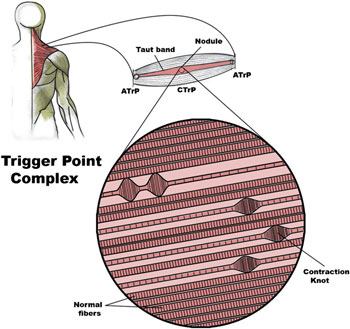Back in May of this year, I posted an article titled Trigger Points (TrP’s) In Detail and thought I would take it a step further by describing additional TrP’s that I learned about via the Precision Neural Mobilization seminar I attended. Before I list them however, please allow me to give you some other details.
1) TrP’s may be caused by several factors, including acute or chronic muscle overload, activation by other TrP’s, disease, psychological distress, homeostatic imbalances, direct trauma to the region, accident trauma, radiculopathy, and infections/health issues.
2) TrP’s form only in muscles—as a local contraction in a small number of muscle fibers located within in a larger muscle or muscle bundle. They can pull on tendons and ligaments associated with the muscle, which in turn, can cause pain deep within a joint where there are no muscles. They can also cause muscle weakness.
3) TrP referral patterns follow specific nerve pathways and have been readily mapped—thanks to Travell & Simons—to aid in the identification of pain. Many TrP’s have pain patterns that overlap, and some create reciprocal cyclic relationships.
4) A taut band in muscles containing TrP’s can feel like hard nodules. Upon palpation, a twitch response can often be felt; activateing the “all or nothing” response in a muscle that causes it to contract. Pressing on an affected muscle can often refer pain, and clusters of TrP’s are not uncommon in some in larger muscles (i.e. the gluteus group).
As promised, here is a list of TrP’s above and beyond what I gave you the last time; the first three being what was listed in my previous post…
- Active – A TrP that causes a clinical pain complaint. It is always tender; prevents full lengthening of a muscle; weakens a muscle; activates a local twitch response when stimulated; direct compression refers patient-recognized pain that is generally in it’s pain reference zone. (Click here for a website that lists reference zones and pain referral patterns.)
- Latent – A TrP that is clinically inactive with respect to spontaneous pain; painful only when palpated. It may have all other characteristics of an active TrP and always has a taut band that increases muscle tension and restricts range of motion (ROM).
- Satellite – A TrP that is influenced neurogenically or mechanically by the activity of a key TrP.
- Associated – A TrP in one muscle that develops in response to compensatory overload, a shortened position, or referred phenomena cause by TrP activity in another muscle. Satellite and secondary TrP’s are types of associated TrP’s.
- Attachement – A TrP at the musculotendinous junction and/or at the osseous attachment of a muscle that identifies the enthesopathy caused by unrelieved tension, characteristic of the taut band that is produced by a central TrP.
- Central – A TrP that is closely associated with dysfunctional end-plates and is located near the center of muscle fibers.
- Key – A TrP responsible for activating one or more TrP’s.
- Primary – A central TrP that is activated by acute or chronic overload, or repetitive overuse of a muscle in which it occurs, and was not activated as a result of TrP activity in another muscle.
The misdiagnosis of pain is the most important issue taken up by Travell and Simons. Referred pain from trigger points mimics the symptoms of a very long list of common maladies, but physicians, in weighing all the possible causes for a given condition, rarely consider a myofascial source. The study of trigger points has not historically been part of medical education. Travell and Simons hold that most of the common everyday pain is caused by myofascial trigger points and that ignorance of that basic concept could inevitably lead to false diagnoses and the ultimate failure to deal effectively with pain.
The above quote comes from a workbook titled The Trigger Point Therapy Workbook. With this book, you will learn about TrP’s and how to treat them; however, it is important for you to keep in mind that if your muscular-skeletal system is misaligned, other muscles are affected, which in my opinion, makes it hard to self-treat in a way that is more than just temporary. Every little bit helps though!
As always, I hope you find this information informative!
* * * * *
“Neutral balance alignment is key to becoming pain free!”™ ~ Me


[…] as of 9/20/12: Here is another post with additional information related to […]
[…] and hamstrings are a few muscles that can mimic sciatica. Trigger points (click here and here for previous posts on TrP’s—and please note that the muscles below, in bold, link to […]